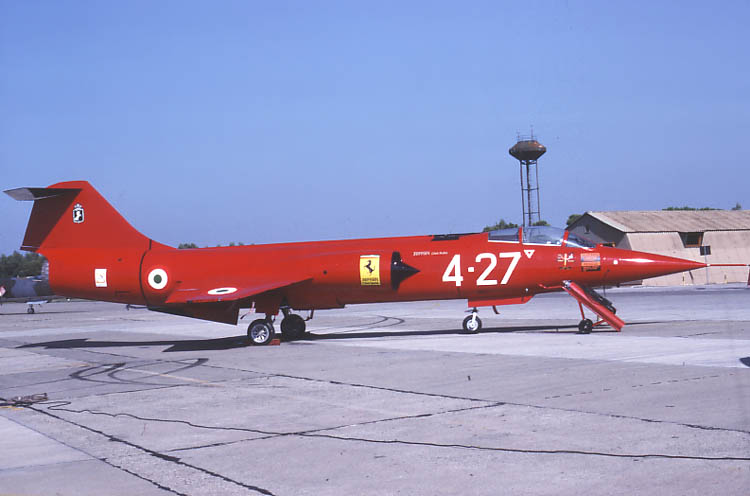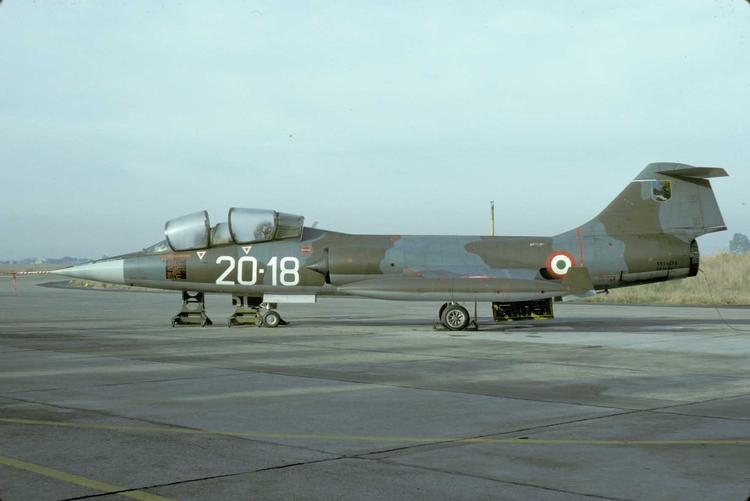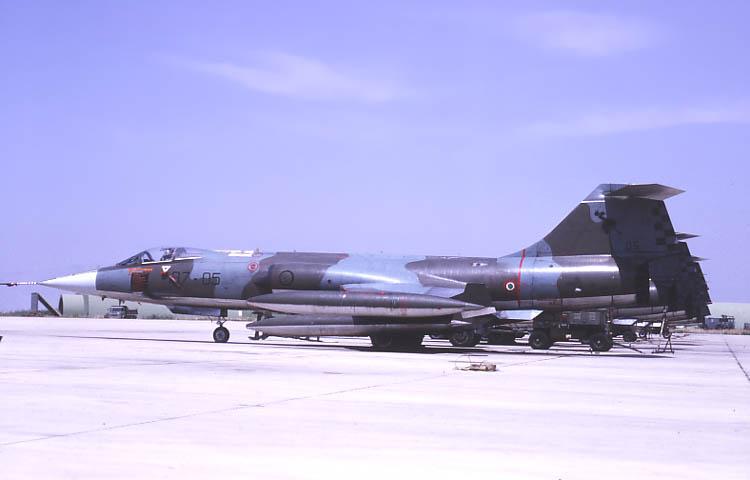|
|
|
F-104 Starfighter of the Italian Air Force |
|
The following AMI units have operated the Starfighter:
9o Gruppo/4o Stormo, Grosetto (from March 1963)
10o Gruppo/o0 Stormo, Grazzanise (from Jan 1967)
12o Gruppo/36o Stormo, Gioia del Colle (from 1965)
20o Gruppo/4o Stormo, Grosseto (from late 1963 to June 1994)
21o Gruppo/53o Stormo, Cameria/Novara (from April 1967)
22o Gruppo/51o Stormo, Treviso/Istrana (from June 1969)
23o Gruppo/5o Stormo, Rimini/Miramare (formed as 101o Gruppo/ 5o Aerobrigata)
(from Sept 1967).
28o Gruppo/3o Stormo, Villafranca, RF-104G from 1964 to June 1993)
102o Gruppo/5o Stormo, Rimini (from May 1964)
132o Gruppo/3o Stormo, Villafranca (1965 to Oct 1990)
154o Gruppo/6o Stormo, Ghedii (1964 to early 1993)
155o Gruppo/51o Stormo (formerly in 50o Stormo Placenza) F-104G until 1974 than
Istrana.
156o Gruppo/36o Stormo, Gioia del Colle, 1966 to 1970.
In the mid-1960s, the Aeronautica Militare Italiana (AMI) received 125
Fiat-built F-104Gs (including 11 RF-104Gs) plus 12 Lockheed-built TF-104Gs and
16 Fiat-built TF-104Gs. The F-104Gs and TF-104Gs first entered service at
Grosseto with 4o Stormo in 1963. These aircraft ultimately equipped four
interceptor/fighter-bomber gruppi, two reconnaissance gruppi, and one training
gruppo.
Seven Lockheed TF-104Gs were transferred to the AMI from the Luftwaffe in
1984/85, and at least two of them were refurbished by Aeritalia, but the others
were probably cannibalized for spares. AMI serials of the 125 Fiat-built F-104Gs
were as follows: MM6501 (pattern aircraft), MM6502/MM6599, MM6601, MM6603,
MM6608/MM6611, MM6631/MM6638, MM6643/MM6651, and MM6658/MM6660. The AMI serials
tracked with Fiat's company numbers, and the gaps in the sequence correspond to
machines which were delivered to Germany and Holland. Serials of the 12
Lockheed-built TF-104G were MM54226 to MM54237. The 16 Aeritalia-built TF-104Gs
were MM54250 to MM54265. Serials of the seven ex-Luftwaffe TF-104Gs were 5738
(ex 27+36), 5739 (ex 27+37) 5743 (ex 27+41), 5902 (ex 27+43), 5919 (ex 27+89),
5946 (ex 28 +16), 5949 (ex 28+19)
In late 1965, the 154o Grouppo based at Ghedi received a NATO Flight Safety
Award after it had flown more than 5000 hours on the F-104G without a single
accident. However, like the air forces of other European operators of the
Starfighter, the accident rate of AMI single-seat F/RF-104Gs and two-seat
TF-104Gs was fairly high, with about 37.5 percent of the force having been lost.
The AMI continued to use the F/RF-104G in large numbers long after other
European air forces had passed their Starfighters along to other users.
Beginning in 1968, the F-104G was supplemented by the much improved F-104S. The
AMI's last F-104G fighter-bomber unit (154o Gruppo/6o Stormo) exchanged its
Starfighters for Panavia Tornadoes from early 1983, leaving 28o Gruppo/3o Stormo
as the last operator of earlier-generation Starfighters with Orpheus sensor
pod-equipped RF-104Gs. These were finally withdrawn from service in June of 1993
The TF-104G two-seaters remained in limited service in 1995. Although most of
the earlier-generation F-104G Starfighters are gone from AMI service,
substantial numbers of the later F-104S type remain in service today.
* Fiat manufactured a total of 125 F-104Gs for the Italian Air Force (Aeronautica
Militaire Italiana / AMI). One of these machines was a pattern aircraft supplied
by Lockheed. The first Fiat built F-104G performed its initial flight on 9 June
1962, with the first operational Starfighter squadrons coming online in 1965.
The Starfighter replaced the F-86 and F-84 / RF-84 in AMI service.
Of the 125 F-104Gs for the AMI, 51 were configured as interceptors, 54 were
configured for the strike role, and 20 were configured as RF-104Gs, with the
built-in trimetrogon camera arrangement. A number of F-104Gs would later be
modified to carry the Dutch Orpheus pod.
The AMI also obtained 12 TF-104Gs from Lockheed and 12 from Aeritalia, giving a
total of 24 trainers. Six more TF-104Gs were passed on from Luftwaffe stocks in
the mid-1980s, with at least two refurbished and some used as spares hulks. The
Italians also considered obtaining a version of the Macchi MB-326 trainer with
NASARR radar and a Starfighter nose, but this project never got out of the paper
stage.
Italian F-104Gs were delivered with the Martin Baker 1Q7A ejection seat. The
Italians were generally consistent in their color schemes, providing their
Starfighters with a dark gray / dark green disruptive pattern on top and light
gray on the bottom. They seemed particularly fond of flashy temporary paint jobs
for special occasions, for example with a stretched-out cat chasing mice on one
side of the fuselage.
* The Italians liked the Starfighter enough to order an enhanced interceptor
variant, the "CL-901" or "F-104S", the "S" indicating carriage of the Sparrow
AAM. Italy considered a number of different aircraft for AMI's interceptor
requirement, including the Dassault Mirage III, the F-4 Phantom, and the F-5,
but despite the Starfighter's accident record the F-104 won out, the award being
announced in 1965. The Phantom was more flexible, but the F-104S was faster,
cheaper and, very importantly, provided more work for the Italian aviation
industry.
Two subvariants were built, the "F-104S/CI" for the interceptor role and the
"F-104S/CB" for the fighter-bomber role. They featured:
An upgraded J79-GE-19 turbojet with 79.6 kN (8,120 kgp / 17,900 lbf) thrust and
13% better fuel economy in cruise. The intakes were moved back very slightly and
widened to provide the necessary additional airflow.
Modernized avionics, including a Litton LN-3-13 INS and an improved NASARR
radar, with the radar built by FIAR of Milan. The interceptor sub variant used
the FIAR / NASARR F15G, which provided Sparrow illumination capabilities, while
the fighter-bomber sub variant used the FIAR / NASARR R21GH radar. The
fighter-bomber also included a radar altimeter.
Nine stores stations, including the wingtip attachment points, two pylons under
each wing, the centreline pylon, and two pylons under the forward fuselage.
A small ventral fin flanking either side of the main ventral fin to improve yaw
stability.
Primary armament of the interceptor sub variant was two AIM-7 Sparrow III AAMs,
plus two or more Sidewinders. The cannon was deleted to make space for Sparrow
control systems. When late-model Sparrows and Sidewinders that were far more
reliable and effective than those used in the 1960s were introduced, the F-104S
was a formidable interceptor. The attack sub variant retained the Vulcan cannon
and could carry a total external warload of 3,400 kilograms (7,500 pounds).
Lockheed modified two Italian F-104Gs into prototypes for the F-104S. The first
prototype flew on 22 December 1966, followed by the second in March 1967. Fiat
built 206 F-104S Super Starfighters for the AMI, the total being split roughly
evenly between interceptors and fighter-bombers, as well as 81 for the Turkish
Air Force. Initial deliveries to the AMI were in 1969, and the last F-104S was
delivered in 1979. Another 40 F-104S Starfighters were built for the Turks,
giving a total production of 246 machines.
Final deliveries of the F-104S led to the AMI's withdrawal of the F-104G from
the interceptor and fighter-bomber roles in the early 1980s, though as mentioned
some F-104Gs were modified to carry the Orpheus pod for the reconnaissance
mission. These reconnaissance machines actually served in the Gulf War in 1991,
flying out of Turkish bases to keep an eye on activities in northern Iraq.
* In the early 1980s an upgrade program, the "Aggiornamento Systema d'Arma / ASA
/ Updated Weapons System", was implemented for 147 AMI F-104S Starfighters,
though the initial plan had been for 153 aircraft. The first upgraded aircraft
was flown in 1984, with service deliveries from 1986 into 1983.
The F-104S ASA featured the improved FIAR R21G/M1 radar with look-down
shoot-down capability; a capable self-defense suite with an RWR and chaff-flare
dispensers; and carriage of the Selenia Aspide 1A AAM, a derivative of the
AIM-7E Sparrow. The Vulcan cannon was refitted to upgraded interceptors, since
the avionics had shrunk considerably in the meantime. In principle the F-104S
ASA could carry the Kormoran antiship missile, though in practice it didn't
happen.
The F-104S ASA was selected basically as an interim solution until the
multinational Eurofighter was available, but as is often the case in
multinational programs, the Eurofighter development effort dragged out. In the
late 1990s, faced with the obsolescence of the Starfighter force, the AMI
decided to lease 24 ex-Royal Air Force Tornado interceptors, and upgrade a
subset of the Starfighter force again.
The modernization program was relatively minimal, focusing mostly on simply
keeping the machines flying safely and doing little to improve combat
effectiveness. The electrical system was replaced, and a new avionics suite was
installed, with a new INS, a (separate) Global Positioning System (GPS)
receiver, and other new kit. 49 F-104S ASA machines were upgraded, being given
the designation of "F-104S ASA-M", and 15 TF-104Gs were upgraded, being given
the designation of "TF-104G-M". The gunsight and countermeasures suite of the
single-seaters were pulled, while all combat gear was yanked from the
two-seaters.
Initial flight of the F-104S ASA-M was in 1995, with initial deliveries in 1997.
These machines served in an operational role in 1999 during OPERATION ALLIED
FORCE, the NATO air campaign against Serbia. The Starfighters were used for
combat air patrols, being occasionally directed by airborne warning and control
aircraft to check out presumably non-hostile bogeys.
Even the ASA-M project was unable to made the Starfighter to soldier on until
the arrival of the Eurofighter. During the wars in the ex-Yugoslavia the ASA-M
showed all its age and was unable to fly along others NATO fighters. It was
relegated to air base protection and deemed unsuitable even for that mission. A
solution fort he retirement of all Italian Starfighter was finally sought in
2004 when 34 old, third-hand F-16A/B ADF, were leased from Lockheed Martin to
replace F-104 within 3 Squadrons.
The last AMI Starfighter was retired in the summer of 2004. At least 138 were
lost in crashes, or about 37.5% of the total.
|
|
 |
 |
 |
|
 |
 |
 |
|
 |
|
|
|